 |
 |
|
 |
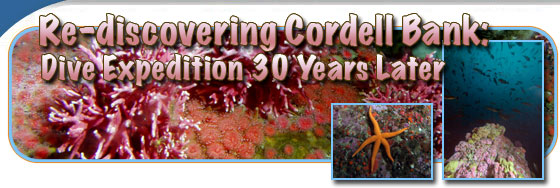
Error processing SSI file
|
Blog: Oct. 7, 2010
Day 1 of Diving
By Russ Green, Deputy Superintendent/Research Coordinator
Thunder Bay National Marine Sanctuary
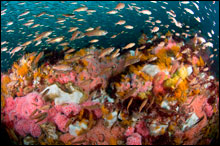 |
| Cordell Bank at its finest! (Photo: Joe Hoyt/CBNMS/NOAA) |
Today the wind and swells that kept us on the dock the past couple of days were nowhere to be found- so it was off to Cordell Bank for our first dives of the project. The past few days have been well spent prepping the 67-foot research vessel Fulmar and all the diving and science-related gear needed for a successful expedition. Last night the entire team met to discuss project objectives, dive sites, expected conditions and specific tasks. The briefing was also a sort of crash course in Cordell Bank ecology for the "bottom team," which consists of six technically trained divers from a variety of science backgrounds. Able to work in depths approaching 300 feet, the collective bottom team has some solid science diving experience, but none of us has ever dived Cordell Bank. The briefing was also something of an historic event. Several members from Cordell Expeditions, the pioneer non-profit organization that first documented in detail this complex undersea landscape, joined us to share reflections on diving, research methodologies and their many discoveries on Cordell Bank. Next year will mark the 30th anniversary of their first forays out to the bank.
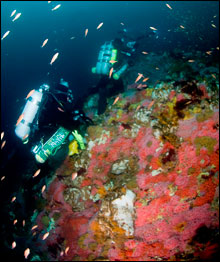 |
| Thor Dunmire and Russ Green dive over the upper ridge of Cordell Bank. (Photo: Joe Hoyt/CBNMS/NOAA) |
With the overcast morning sky gradually clearing, the RV Fulmar made the hour and a half transit to the site and quickly found the section of the bank that would be the focus of today's diving. After marking the site with a down-line (a weighted line with an orange surface buoy that gives divers a reference as they make their way to a specific spot on the bottom), the first dive team donned their drysuits and strapped on their dive gear- all 170 pounds of it! With four scuba tanks variously configured on their bodies and equipment such as video and still cameras, lights, specimen collection tools and "goodie" bags, it wasn't a problem for the divers to quickly make the couple minute trip to a reef pinnacle 150 feet below. There was maybe a 1 or 1.5 knot current on the way down and even a bit of surge on the bottom, probably due to the slight remaining swell we noticed while topside.
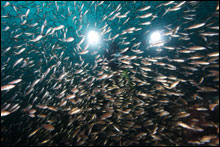 |
| Thick schools of juvenile rockfish above Cordell Bank. (Photo: Greg McFall/CBNMS/NOAA) |
Once on the bottom, my immediate and powerful first impression was that this place is full of life! Rockfish swarmed our three person dive team, with numbers so great that they actually obscured our visibility. Pushing through this swirling mass to get a better view of the bottom revealed the vibrant colors and different textures of corals, sponges and other marine life that carpet nearly every inch of Cordell Bank's upper reaches. Our team took video and still imagery and collected samples, as did the second three-person dive team that followed us. Our dive lasted about 65 minutes, roughly 30 of which was on the bottom, while the remainder was spent decompressing at various depths in the water column as we made our way slowly to the surface.
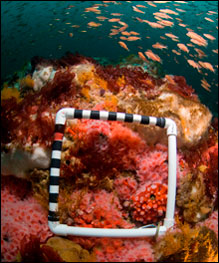 |
| Photo quadrat on invertebrate cover of Cordell Bank. (Photo: Joe Hoyt/CBNMS/NOAA) |
It was a good day, with researchers from Cordell Bank NMS, Cordell Expeditions, and the California Academy of Sciences all excited about the day's productivity. Today's results: several gigabytes of digital photos and video, and dozens of specimens destined for preservation and future research at the California Academy of Sciences. Yet, for those of us fortunate enough to dive today, getting meaningful data is only half of the story. We were also welcomed into a small group of divers lucky enough to visit Cordell Bank firsthand, and be rewarded with indelible, highly individual impressions of an undersea place that is a world unto itself.
|
|
 |



